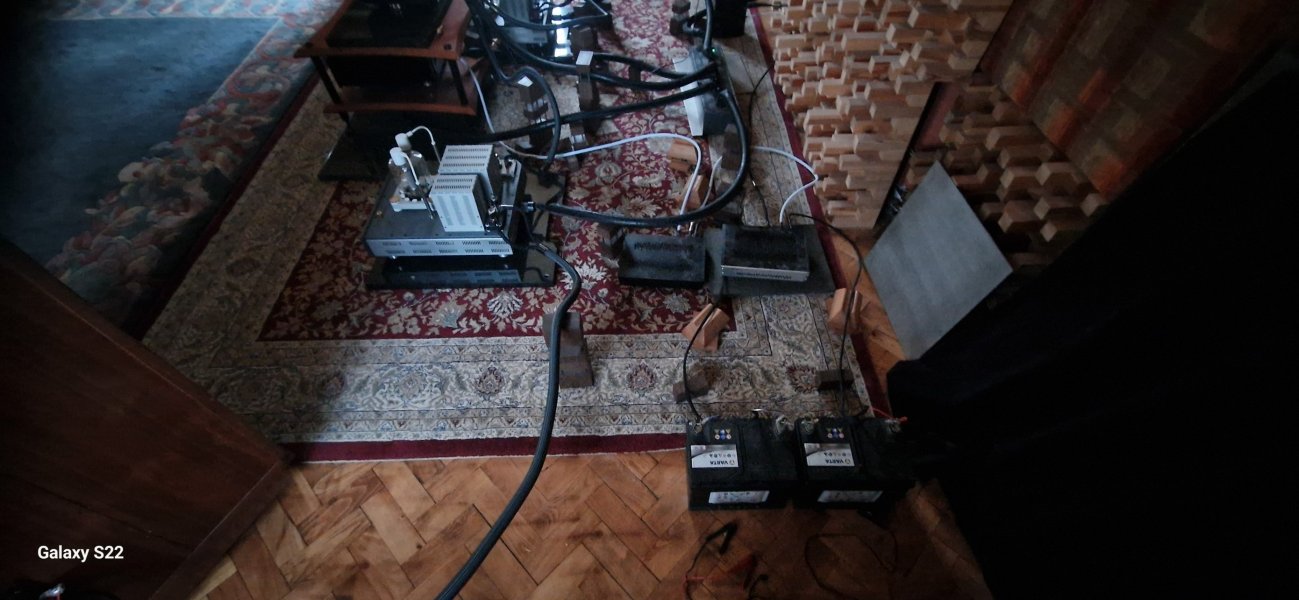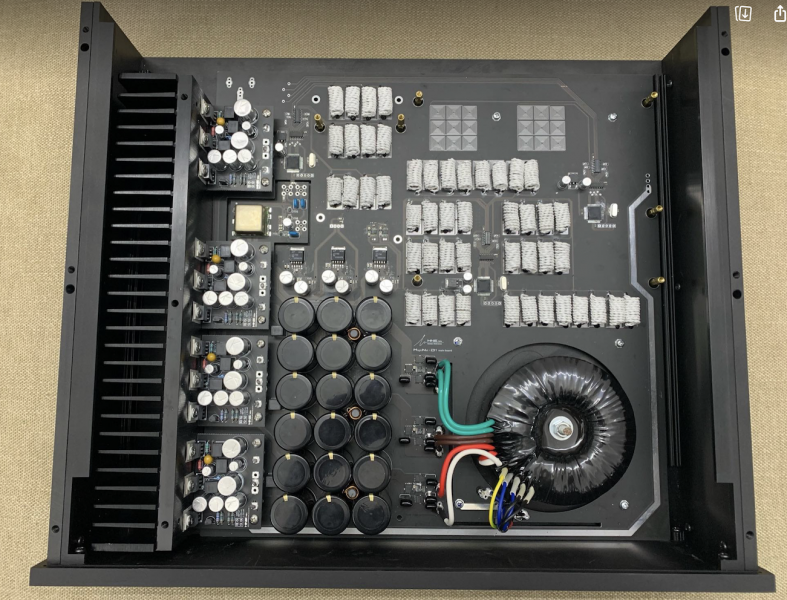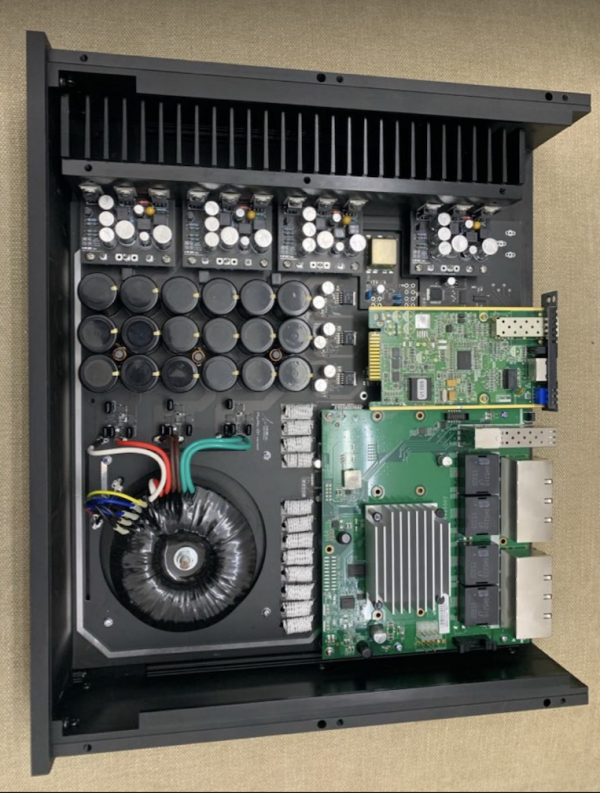It's good to hear that many people tried isolators already. I think a good idea for a beginner is to get a medical-grade isolator. They hold value pretty well, so it's easy to get your money back. Additionally, they have guaranteed low leakage which is very important in audio. When we connect lots of different devices, leakage currents can induce noise.
Do I really need an " Audio Grade Network Switch "?
- Thread starter Preston8452
- Start date
You are using an out of date browser. It may not display this or other websites correctly.
You should upgrade or use an alternative browser.
You should upgrade or use an alternative browser.
New Switch on it's way. Brand new design and layout. Will be layering two of HNEs switches, this one is being added to my existing HNE switch pictured in this thread. I will keep you updated on what I hear!
Last one was equivalent to the difference of adding a nice preamp to my system.
Last one was equivalent to the difference of adding a nice preamp to my system.
Attachments
Is HNE from Vietnam? I had never heard of that brand before. There are a lot of small companies manufacturing excellent products but I guess it would be impossible for ”legal” reasons to use one in EU.. I think you know that all products using 230 volt must have a CE certification when sold within EU. If imported directly from a non EU country the importer takes full responsibility if something goes wrong. Risky.
Prior buying Farad I saw that an UK LPS manufacturer lacked that certificate so I took it out from my shortlist.
Never the less I am curious to here what you think of the new on. True, a good Switch / LPS is like a pre amp upgrade.
Prior buying Farad I saw that an UK LPS manufacturer lacked that certificate so I took it out from my shortlist.
Never the less I am curious to here what you think of the new on. True, a good Switch / LPS is like a pre amp upgrade.
Have you received it ? Can you make comments on the sq of this new switch .New Switch on it's way. Brand new design and layout. Will be layering two of HNEs switches, this one is being added to my existing HNE switch pictured in this thread. I will keep you updated on what I hear!
Last one was equivalent to the difference of adding a nice preamp to my system.
I am interested by this HNE switch .
I have not read any comments on this issue but I will share my experience. After I tried all kind of diffrent PS I tried to use a battery as a main PS. What a diffrence, so much more analog sounding, all that was getting better when I added one more switch in parallel and obtained highend ethernet Cables from AAI Maestozo. Now I am set for a while. I am sure I can still get better with something in the market since the streaming is growing so fast. I am happy now with this solution, it sounds very close to analog(Tambaqui, Pink Faun as a source).

Last edited:
Looks interesting. Please explore.I have not read any comments on this issue but I will share my experience. After I tried all kind of diffrent PS I tried to use a battery as a main PS. What a diffrence, so much more analog sounding, all that was getting better when I added one more switch in parallel and obtained highend ethernet Cables from AAI Maestozo. Now I am set for a while. I am sure I can still get better with something in the market since the streaming is growing so fast. I am happy now with this solution, it sounds very close to analog(Tambaqui, Pink Faun as a source).View attachment 118927
I see Varta. Which model and approx price.
Very late to the discussion but I would like to add that these Ethernet tweaks have a limit - the best possible sound is if there is no LAN connection.
Normally if one disconnects the LAN from a streamer to hear the effect, the music stops or at the very least the controls stop functioning. So this is not possible for long term use. But it's possible to hear the effects of the best possible LAN connection, one that is not connected. The playback software need to have a full buffering function like Euphony v4 which I current use. It allows a full buffering of local and streaming Tidal/Qobuz tracks into the RAM and plays from there. So once buffered, one can disconnect the LAN cable and playback of the playlist still continues.
There is one further point that once the LAN cable is disconnected, the OS might continue to search for a working connection thereby increasing the workload and affecting the sound adversely. Euphony v4 has a function to switch off the network systems for a set period of time. So this can be used during the LAN disconnect hearing tests to avoid this handshake loading.
Having tried this on my Pink Faun system, I found very little difference between my current network set up :
Orbi wireless satelite (powered by Paul Hynes DR7t+) -->
Trio of SOtM ethernet cables (dCBL-CAT7, iSO-CAT6, dCBL-CAT7) -->
Pink Faun 2.16x streamer / Euphony v4 operating normally
vs.
A disconnect of the LAN cable from the streamer with Euphony switching off PF's networks.
This means my network is mostly optimised for my current setup and no further attention is needed. Furthermore I can return to playing with the LAN cable connected and ethernet functions turned on without any sound degradation.
or it could mean my system is poor and isn't resolving enough to hear the LAN issues!
Normally if one disconnects the LAN from a streamer to hear the effect, the music stops or at the very least the controls stop functioning. So this is not possible for long term use. But it's possible to hear the effects of the best possible LAN connection, one that is not connected. The playback software need to have a full buffering function like Euphony v4 which I current use. It allows a full buffering of local and streaming Tidal/Qobuz tracks into the RAM and plays from there. So once buffered, one can disconnect the LAN cable and playback of the playlist still continues.
There is one further point that once the LAN cable is disconnected, the OS might continue to search for a working connection thereby increasing the workload and affecting the sound adversely. Euphony v4 has a function to switch off the network systems for a set period of time. So this can be used during the LAN disconnect hearing tests to avoid this handshake loading.
Having tried this on my Pink Faun system, I found very little difference between my current network set up :
Orbi wireless satelite (powered by Paul Hynes DR7t+) -->
Trio of SOtM ethernet cables (dCBL-CAT7, iSO-CAT6, dCBL-CAT7) -->
Pink Faun 2.16x streamer / Euphony v4 operating normally
vs.
A disconnect of the LAN cable from the streamer with Euphony switching off PF's networks.
This means my network is mostly optimised for my current setup and no further attention is needed. Furthermore I can return to playing with the LAN cable connected and ethernet functions turned on without any sound degradation.
or it could mean my system is poor and isn't resolving enough to hear the LAN issues!
Interesting Idea, maybe playing from a battery powered offline buffer is the future of streaming...Very late to the discussion but I would like to add that these Ethernet tweaks have a limit - the best possible sound is if there is no LAN connection.
Normally if one disconnects the LAN from a streamer to hear the effect, the music stops or at the very least the controls stop functioning. So this is not possible for long term use. But it's possible to hear the effects of the best possible LAN connection, one that is not connected. The playback software need to have a full buffering function like Euphony v4 which I current use. It allows a full buffering of local and streaming Tidal/Qobuz tracks into the RAM and plays from there. So once buffered, one can disconnect the LAN cable and playback of the playlist still continues.
There is one further point that once the LAN cable is disconnected, the OS might continue to search for a working connection thereby increasing the workload and affecting the sound adversely. Euphony v4 has a function to switch off the network systems for a set period of time. So this can be used during the LAN disconnect hearing tests to avoid this handshake loading.
Having tried this on my Pink Faun system, I found very little difference between my current network set up :
Orbi wireless satelite (powered by Paul Hynes DR7t+) -->
Trio of SOtM ethernet cables (dCBL-CAT7, iSO-CAT6, dCBL-CAT7) -->
Pink Faun 2.16x streamer / Euphony v4 operating normally
vs.
A disconnect of the LAN cable from the streamer with Euphony switching off PF's networks.
This means my network is mostly optimised for my current setup and no further attention is needed. Furthermore I can return to playing with the LAN cable connected and ethernet functions turned on without any sound degradation.
or it could mean my system is poor and isn't resolving enough to hear the LAN issues!
I can take the LAN connection of my Statement offline and it does slightly sweeten local playback. It shows me my 3 switches and power supplies and ethernet cable filters could be better?
I am curious to try the Waversa filters. Of course the expensive one is better but how much better, and how does the lower cost one compare to products like the ENO and SOtM and the like?
Hi,Very late to the discussion but I would like to add that these Ethernet tweaks have a limit - the best possible sound is if there is no LAN connection.
Normally if one disconnects the LAN from a streamer to hear the effect, the music stops or at the very least the controls stop functioning. So this is not possible for long term use. But it's possible to hear the effects of the best possible LAN connection, one that is not connected. The playback software need to have a full buffering function like Euphony v4 which I current use. It allows a full buffering of local and streaming Tidal/Qobuz tracks into the RAM and plays from there. So once buffered, one can disconnect the LAN cable and playback of the playlist still continues.
There is one further point that once the LAN cable is disconnected, the OS might continue to search for a working connection thereby increasing the workload and affecting the sound adversely. Euphony v4 has a function to switch off the network systems for a set period of time. So this can be used during the LAN disconnect hearing tests to avoid this handshake loading.
Having tried this on my Pink Faun system, I found very little difference between my current network set up :
Orbi wireless satelite (powered by Paul Hynes DR7t+) -->
Trio of SOtM ethernet cables (dCBL-CAT7, iSO-CAT6, dCBL-CAT7) -->
Pink Faun 2.16x streamer / Euphony v4 operating normally
vs.
A disconnect of the LAN cable from the streamer with Euphony switching off PF's networks.
This means my network is mostly optimised for my current setup and no further attention is needed. Furthermore I can return to playing with the LAN cable connected and ethernet functions turned on without any sound degradation.
or it could mean my system is poor and isn't resolving enough to hear the LAN issues!
please, may I know which type of plug has the DC cable connector to Orbi satellite. Is it a 5.5 x 2.5 male connector?
Hi,
please, may I know which type of plug has the DC cable connector to Orbi satellite. Is it a 5.5 x 2.5 male connector?
The DC cable male connector going into the Orbi satellite is a standard 5.5/2.1mm barrel.
Thank you.The DC cable male connector going into the Orbi satellite is a standard 5.5/2.1mm barrel.
Another believer in the use of audiophile switches, LPS’ and quality power cables. Also the Ferrum Hypsos power supply combines the best of a LPS and switched power supply.
I use the SoTM, Melco and Telegartner, in that order. The Melco and Telegartner are powered by the Sean Jacobs LPS. Excellent. The SoTM and Orbi router use the Ferrum Hypsos power supply.
Use of these devices has made streaming a totally different experience. You can listen to streamed music critically although a local file still slays it!
I’m about to replace my primary 6 year old Ethernet feed cable (upgrade) as my next step.
An important takeaway from all these posts is the importance of power in network audio. It’s critical.
I use the SoTM, Melco and Telegartner, in that order. The Melco and Telegartner are powered by the Sean Jacobs LPS. Excellent. The SoTM and Orbi router use the Ferrum Hypsos power supply.
Use of these devices has made streaming a totally different experience. You can listen to streamed music critically although a local file still slays it!
I’m about to replace my primary 6 year old Ethernet feed cable (upgrade) as my next step.
An important takeaway from all these posts is the importance of power in network audio. It’s critical.
The Etherregen tricked out with a decent LPS and reclocked with a quality clock is no slouch. In my system I use a netgear and an Lhyaudio OCXO switch in front of it. Daisy chaining switches is actually an alternative to going fibre, which in the conversion process has its own challenges with regard to soundstage, attack and decay.
No such issues here, Corning single-mode fiber with Finisar FTLF1318P3BTL SFPs bested copper in every way.fibre, which in the conversion process has its own challenges with regard to soundstage, attack and decay.
Republicoftexas69
Well-Known Member
Actually not.The Etherregen tricked out with a decent LPS and reclocked with a quality clock is no slouch. In my system I use a netgear and an Lhyaudio OCXO switch in front of it. Daisy chaining switches is actually an alternative to going fibre, which in the conversion process has its own challenges with regard to soundstage, attack and decay.
The Etherregen tricked out with a decent LPS and reclocked with a quality clock is no slouch. In my system I use a netgear and an Lhyaudio OCXO switch in front of it. Daisy chaining switches is actually an alternative to going fibre, which in the conversion process has its own challenges with regard to soundstage, attack and decay.
How so?
It needs a power supply and both the supply and the conversion process create noise, and add their own signatures to the resulting sound quality. The power supply quality and noise have an impact on soundstage, attack and decay, amongst other things.How so?
It needs a power supply and both the supply and the conversion process create noise, and add their own signatures to the resulting sound quality. The power supply quality and noise have an impact on soundstage, attack and decay, amongst other things.
Depends on implementation..The fiber connection cuts the noise from any power supply or etheret related noise (which is all your trying to mitigate). There is no need to layer switches, just use fiber to decouple from all the noise downstream related to your router etc, then cut noise with fiber, then use a hifi switch right before the source. Which btw also has a power supply, so does your DAC, preamp, amp etc etc. If anything, a properly implemented power supply in the circuit will increase all the things you are claiming will be negatively impacted.
It is not true that fiber cuts all upstream noise. I can clearly hear changes in ethernet cables, switches and power supplies upstream of the fiber conversion. Here's John Swenson's explanation:Depends on implementation..The fiber connection cuts the noise from any power supply or etheret related noise (which is all your trying to mitigate). There is no need to layer switches, just use fiber to decouple from all the noise downstream related to your router etc, then cut noise with fiber, then use a hifi switch right before the source.
Q. What about fiber-optic interfaces? Don’t these block everything?
A. In the case of a pure optical input (zero metal connection), this does block leakage current, but it does not block phase-noise affects. The optical connection is like any other isolator: jitter on the input is transmitted down the fiber and shows up at the receiver. If the receiver reclocks the data with a local clock, you still have the effects of the ground plane-noise from the data causing threshold changes on the reclocking circuit, thus overlaying on top of the local clock.
Similar threads
- Replies
- 10
- Views
- 2K
- Replies
- 92
- Views
- 5K
- Replies
- 18
- Views
- 2K
- Replies
- 6
- Views
- 2K
- Replies
- 16
- Views
- 4K



